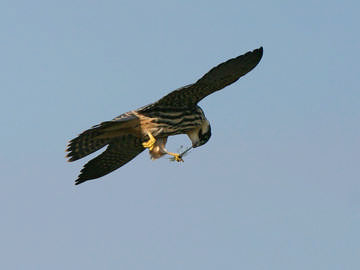Hobby (Falco subbuteo)

Hobby © Steve Round
Cheshire has shared in the northern spread of this spectacular bird of prey and its county population is now larger than at any time in the history of ornithological recording. Hobbies bred occasionally during the 19th century, when most birds seen were shot, but the only nests known to Coward and Oldham (1910) were in 1895 and 1898. The next proven breeding came exactly a century later in 1998, following an increasing number of summer sightings during the 1990s; occasional records had strongly hinted at breeding, including a pair which nested successfully in 1996, and probably in 1995, about 200 m outside the county boundary. Since then they have increased greatly and the fieldwork for this Atlas shows that there may be as many as 50 pairs breeding in the county.
Several suggestions have been put forward to explain their increase and northward spread in England, including the similar expansion of several dragonfly species (Prince & Clarke 1993); greater availability of corvid nests because of reduced persecution (Chapman 1999); and mechanised farming meaning fewer humans in the countryside (Messenger and Roome 2007). For a bird so closely associated with warm summer days, climate change is surely implicated, as well.
Hobbies are one of the latest breeding species and most arrive back from their southern African wintering grounds – believed to lie in the Zambezi basin between 10º S and 20º S – during May. On arrival in the nesting territory in spring, the male calls frequently and flies conspicuously over the woodland canopy, or the former nesting area; [it is surprising that no ‘D’ (display) records were submitted as breeding status codes]. They nest anywhere with a good view, typically 15 m above ground in a hedgerow tree or an open area on the edge of woodland. The frequently-cited preference of Hobbies for nesting in Scots Pines is erroneous, a result of their being the commonest trees in the southern English heathlands where earlier studies were performed (Fiuczynski & Nethersole-Thompson 1980). In Derbyshire, 84 out of 106 known nests were in Oak (Messenger & Roome 2007). More than 90% of Hobbies use an old Crows’ nest, about half of them from earlier in the same season, the Crow chicks having already fledged before the Hobby’s arrival. The female usually lays three eggs and starts incubating from mid-June whilst the male provides her with food, an average of 2.6 birds per day. Incubation lasts for four weeks, followed by a fledging period of four to five weeks.
Hobbies fiercely defend their nest area against potential predators such as Kestrels, Buzzards and corvids (Chapman 1999). Woodpigeons often choose to nest near to a Hobby, even in the same tree, as was noted in the first breeding in the south-east of Cheshire (Stubbs 2001). This is probably a symbiotic relationship, the pigeons gaining from the raptor's defence against predators, and the Hobbies having another species alerting them to threats.
In Cheshire, Hobbies are a farmland bird, settling wherever there is sufficient prey. Two-thirds of submitted habitat codes were farmland, mostly improved grassland (32%), unimproved grassland (11%) and mixed grassland/ tilled land (19%), with 18% woodland. They catch their food on the wing. Moths, butterflies and dragonflies are mainly taken and eaten by the adults themselves, although if they are superabundant, the male brings lots of insects to his brooding mate. Their favoured avian prey is hirundines. Sand Martins dread visits to their colonies by this species more than any other raptor: colonies return to normal within a minute or two of an attack by Sparrowhawk or Kestrel, even if successful, whereas they often take ten or fifteen minutes to recover from a Hobby’s visit. They have evolved a special alarm call, as have Swallows, different from that given for other aerial predators. This is obviously innate, as was demonstrated at Cheshire Sand Martin colonies in the 1990s that had never previously experienced Hobby attacks. They have been recorded taking at least 70 different species in Europe (BWP), and various English studies have found them taking at least 36 species, including almost every small- or medium-sized bird of open habitats: Swifts, larks, pipits, tits, sparrows, finches and buntings, as well as noctule bats (Chapman 1999).
The submissions for this Atlas total 37 tetrads with confirmed or probable breeding and a number of other areas with clusters of records. A few of the records might refer to a pair moving across tetrad boundaries, either within a season or from year to year, but there must have been other pairs that were missed, bearing in mind that this is a difficult species in which to prove breeding. Hobbies do not normally breed until two years of age and some of the odd birds that turn up could be non-breeders. Nevertheless, the county total must surely lie in the range 40-50 pairs, probably towards the upper end of that band.
There are several ways of expressing the territory size or nesting density of Hobbies. In prime habitat a pair of Hobbies keep a home range of about 750 ha, an area of almost two tetrads; the nearest-neighbour spacing between nests averages 4.5 km, ranging from 1.5 to 7.3 km; and a number of English studies find a mean of 1.3 to 4.9 breeding pairs per 100 km2 (Chapman 1999). Based on these figures and the Atlas map, some parts of eastern Cheshire must now have reached their carrying capacity and be ‘full’ of Hobbies, a remarkable position less than a decade after their re-colonisation of the county.
Sponsored by Pete Hall

